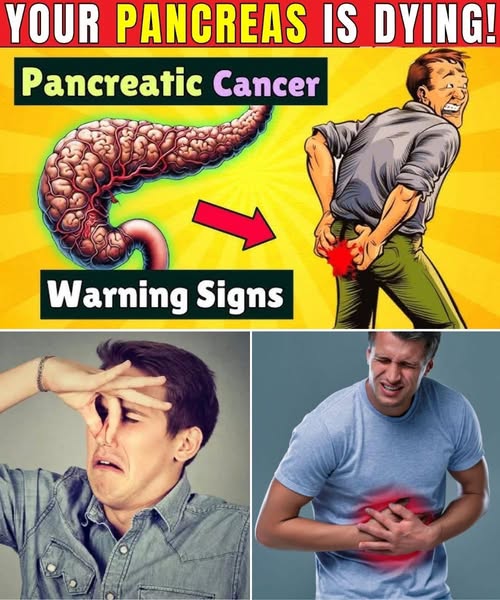Introduction

Pancreatic cancer is one of the deadliest and most elusive types of cancer. With a staggering 5-year survival rate of just around 12%, it ranks among the most fatal cancers globally. What makes pancreatic cancer so dangerous? It often hides in plain sight, silently progressing until it’s too late to treat effectively. That’s why knowing the early signs and symptoms—even the subtle ones—is critical.
In this blog post, we’ll reveal the 8 most shocking and silent symptoms of pancreatic cancer. Some may seem unrelated to cancer at first glance, but they are critical warning signs you should never overlook. Understanding these early clues could help you or a loved one detect the disease in time, seek medical help, and potentially save a life.
Body
What Is Pancreatic Cancer?
Pancreatic cancer occurs when malignant cells form in the tissues of the pancreas, an essential organ behind the stomach that helps with digestion and blood sugar regulation. There are two main types:
- Exocrine tumors (about 95% of cases): These affect the part of the pancreas that produces digestive enzymes.
- Endocrine tumors: These are rarer and affect hormone-producing cells.
8 Symptoms of Pancreatic Cancer That Will Shock You
1. Unexpected Weight Loss
Unintentional weight loss is often the first red flag. Losing more than 10% of your body weight without trying could signal a problem with digestion or nutrient absorption—functions heavily influenced by the pancreas.
🟠 Why it matters: Pancreatic tumors can block enzyme production, preventing your body from breaking down food properly.
📊 Stat Alert: According to the American Cancer Society, more than 80% of pancreatic cancer patients experience sudden weight loss.
2. Persistent Abdominal or Back Pain
A dull pain in the upper abdomen that may radiate to your back is another commonly overlooked symptom. This pain may be intermittent or constant and is often mistaken for a pulled muscle or poor posture.
🟠 Why it matters: As the tumor grows, it can press against nearby nerves or organs.
💡 Pro Tip: If this pain worsens when lying down or after eating, it’s worth a closer look.
3. Jaundice (Yellowing of the Skin and Eyes)
Jaundice may look like a liver issue, but it can be an early symptom of pancreatic cancer—especially when the tumor is near the common bile duct, blocking bile flow.
🟠 Why it matters: Even without pain, jaundice should never be ignored. It often shows up as yellow skin, dark urine, or pale stools.
📊 Stat Alert: Up to 70% of people with pancreatic head tumors report jaundice as an early symptom.
4. Loss of Appetite or Feeling Full Quickly
Feeling full after just a few bites? This could signal a mass pressing against your stomach or surrounding tissues.
🟠 Why it matters: The pancreas lies close to the stomach, and tumors can directly interfere with digestion and satiety signals.
💡 Pro Tip: Appetite changes accompanied by fatigue or pain deserve urgent attention.
5. New-Onset Diabetes
Sudden diabetes, especially in adults over 50 with no family history or risk factors, can be a surprising sign of pancreatic dysfunction.
🟠 Why it matters: The pancreas produces insulin. A tumor can impair insulin production, leading to high blood sugar levels and, eventually, diabetes.
📊 Fact Check: About 40% of pancreatic cancer patients are diagnosed with diabetes within 2 years before cancer detection.
6. Greasy or Light-Colored Stools
Pancreatic cancer can reduce the amount of digestive enzymes, causing malabsorption. As a result, stools may become greasy, float, and appear light in color.
🟠 Why it matters: These changes often reflect fat malabsorption and are a red flag for pancreatic insufficiency.
💡 Take Action: If you’re frequently experiencing such changes, consult a gastroenterologist.
7. Extreme Fatigue
While fatigue can be caused by many factors, the crushing tiredness linked to pancreatic cancer doesn’t go away with rest and is often paired with other warning signs.
🟠 Why it matters: Cancer-related fatigue results from the body’s energy being redirected to fight off illness or manage tumor-related inflammation.
📊 Fact: In clinical studies, nearly 85% of patients reported persistent fatigue as a symptom before diagnosis.
8. Itchy Skin Without Rash
Unexplained, persistent itchiness—especially on the palms or soles—can be an early sign of bile buildup in the body, due to pancreatic blockage.
🟠 Why it matters: This is usually linked to jaundice and should be investigated immediately, especially if paired with other symptoms.
💡 Pro Tip: Pay close attention to any new skin sensations. Itchiness from bile isn’t relieved by lotions or antihistamines.
Frequently Asked Questions (FAQs)
✅ What age group is most at risk for pancreatic cancer?
Pancreatic cancer is most commonly diagnosed in people over age 60, although younger individuals can still be affected, especially those with genetic predispositions.
✅ Is pancreatic cancer curable if caught early?
Yes. Early-stage pancreatic cancer has a much better prognosis. If detected before it spreads, surgical removal of the tumor offers the best chance for survival. Unfortunately, only about 20% of cases are caught early enough for surgery.
✅ Can lifestyle choices reduce the risk?
Absolutely. Quitting smoking, maintaining a healthy weight, exercising regularly, and managing diabetes can lower your risk significantly.
✅ Are there screening tests for pancreatic cancer?
Currently, there is no standard screening test for the general population. However, high-risk individuals (such as those with a family history or genetic disorders) may benefit from specialized imaging or endoscopic ultrasounds.
Why You Must Act Fast
Pancreatic cancer is often called a “silent killer” for a reason. It progresses stealthily, and by the time symptoms become obvious, the cancer is often in an advanced, less treatable stage.
Early detection is your best defense. If you notice any combination of the symptoms above—especially persistent pain, jaundice, or unexplained weight loss—don’t wait. See a healthcare provider immediately and request tests such as:
- CT scan
- MRI
- Endoscopic ultrasound (EUS)
- Blood test for tumor markers (like CA 19-9)
Conclusion
Pancreatic cancer might be rare, but it’s ruthlessly aggressive and often diagnosed too late. By staying informed and recognizing even the subtlest of symptoms, you can dramatically improve the chances of early detection—and survival.
Here’s a quick recap of the 8 shocking symptoms of pancreatic cancer:
- Unexplained Weight Loss
- Persistent Abdominal or Back Pain
- Jaundice
- Loss of Appetite or Early Satiety
- New-Onset Diabetes
- Greasy or Pale Stools
- Chronic Fatigue
- Unexplained Itching
These are critical warning signs—not to be ignored, brushed off, or self-diagnosed. Your health is your most valuable asset. If something feels “off,” listen to your body and seek help.
🔔 Remember: Sharing this information might save someone’s life. Don’t keep it to yourself—forward it, post it, and talk about it. Early awareness is the ultimate life-saving tool.


